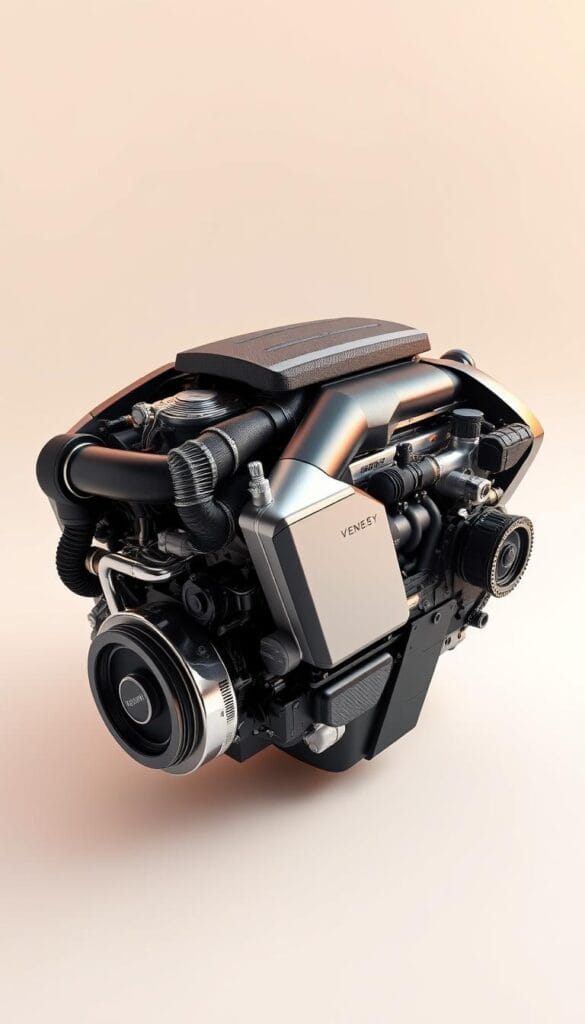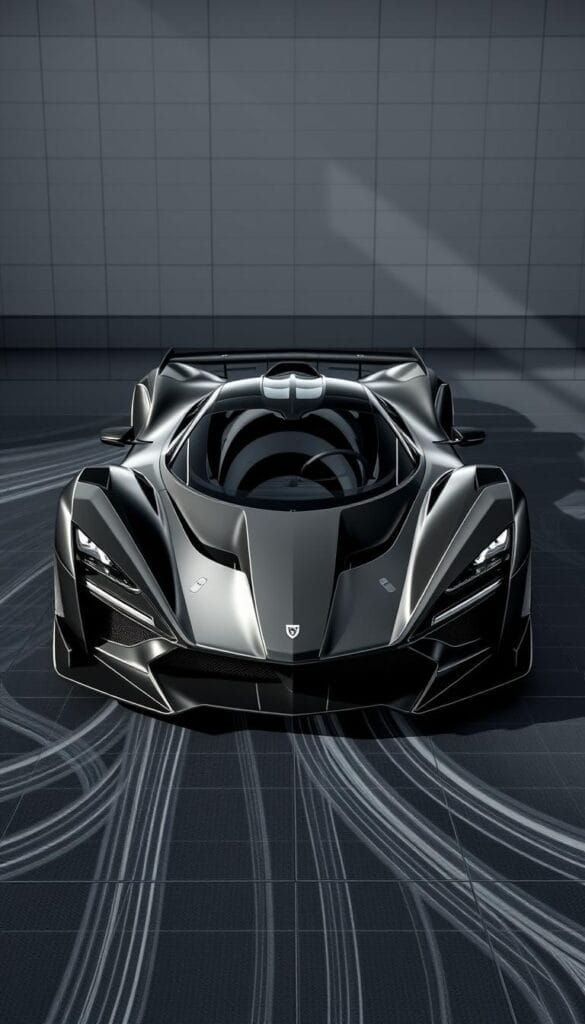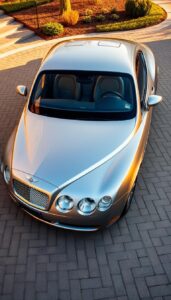Imagine standing at the edge of automotive history. Here, raw engineering meets unbridled passion. The Hennessey Venom F5 is not just another hypercar. It’s a revolutionary machine designed to shatter every performance barrier.
Your pulse quickens as you think about a vehicle engineered to break the mythical 300 mph barrier. It’s the ultimate expression of hypercar performance.
This extraordinary machine from Texas-based Hennessey Performance Engineering represents more than mere speed. It embodies human ambition, technological innovation, and the relentless pursuit of pushing boundaries beyond conventional limits. The Venom F5 isn’t just challenging speed records. It’s rewriting the entire narrative of automotive excellence.
With its record-breaking speed potential, the Hennessey Venom F5 stands as a testament to what’s possible when engineering genius meets uncompromising vision. You’re witnessing a moment where automotive technology transcends traditional expectations. It creates a hypercar that represents the pinnacle of human mechanical achievement.
Key Takeaways
- Hennessey Venom F5 aims to break the 300 mph speed barrier
- Represents cutting-edge hypercar performance engineering
- Developed by Texas-based Hennessey Performance Engineering
- Pushes technological boundaries of automotive design
- Symbolizes human ambition in automotive innovation
The Evolution of Hypercar Speed Records
The world of elite engineering has seen a fierce battle among top car makers. They’ve pushed speed and exclusive automotive performance to new heights. Hypercar makers have changed the game, making cars that test human engineering limits.
The Ultimate Speed Competition
At the core of this amazing journey is a fierce rivalry. Bugatti, Koenigsegg, and Hennessey are at the forefront. Each aims to break speed records and redefine car engineering.
- Bugatti: Known for the Chiron Super Sport 300+
- Koenigsegg: Pioneer of radical speed innovations
- Hennessey: Pushing boundaries with the Venom F5
Historical Speed Milestones
The quest for speed has never stopped. Fans have marveled as these makers broke records again and again. They show incredible tech skills.
| Year | Manufacturer | Top Speed | Vehicle |
|---|---|---|---|
| 2005 | Bugatti | 253 mph | Veyron |
| 2010 | Bugatti | 267 mph | Veyron Super Sport |
| 2019 | Bugatti | 304 mph | Chiron Super Sport 300+ |
Current Record Holders
Today, hypercar makers keep pushing tech limits. They create elite engineering wonders that wow car fans everywhere. The chase for the fastest speed is as thrilling as ever.
Understanding the Hennessey Venom F5’s Engineering Marvel
The Hennessey Venom F5 is a huge step forward in car design and performance. It’s not just a car; it’s a complete new creation. Hennessey has moved from just modifying cars to being a true leader in car design.

- Completely custom-designed chassis
- Advanced carbon fiber monocoque construction
- Precision-engineered aerodynamic components
- Lightweight materials optimized for extreme performance
The Venom F5’s engineering is not just about design. It’s about making a car that’s fast and handles well. The Hennessey team worked hard to make a car that breaks new ground in car technology.
| Engineering Aspect | Unique Features |
|---|---|
| Chassis Design | Full carbon fiber monocoque |
| Weight Optimization | Lightweight materials reducing total mass |
| Aerodynamic Efficiency | Custom-designed body panels |
Exploring extreme car engineering starts with the Venom F5’s groundbreaking design. It’s not just a fast car; it shows what humans can achieve in car design.
Power and Performance Specifications
The Hennessey Venom F5 is the top hypercar, offering an unmatched high-velocity drive. It’s built for record-breaking speed, thanks to its advanced powertrain. This engine is designed to give you the best performance possible.

6.6L Twin-Turbo V8 Engine Capabilities
The Venom F5 starts with a 6.6L twin-turbocharged V8 engine. This engine is a game-changer, pushing the limits of what a hypercar can do. It’s a leap forward in car technology.
- Displacement: 6.6 liters of pure engineering excellence
- Configuration: Twin-turbocharged V8
- Cooling system: Advanced thermal management
Transmission and Drivetrain Details
Turning raw power into a smooth drive needs smart engineering. The Venom F5 has a 7-speed single-clutch semi-automatic transmission. It’s rear-wheel drive for the best performance.
Horsepower and Torque Figures
The Venom F5’s performance is truly amazing. It has 1,600 horsepower and 1,300 lb-ft of torque. This means it can go incredibly fast, setting new records.
| Performance Metric | Specification |
|---|---|
| Horsepower | 1,600 hp |
| Torque | 1,300 lb-ft @ 4,400 rpm |
| Transmission | 7-Speed Single-clutch Semi-automatic |
| Drivetrain | Rear-Wheel Drive |
Top Speed Hennessey Venom F5 Luxury Cars 300+ MPH

The Hennessey Venom F5 is a top speed marvel in the world of luxury cars. It aims to break speed records, showing what high-performance cars can do. Hennessey Special Vehicles is leading this exciting challenge, drawing fans of speed from all over.
Reaching over 300 mph is a big deal. The team is working hard to make sure the speed is real. They use a special method to check the car’s speed, making sure it’s accurate. Hennessey’s plan is to do this in a way that everyone can trust.
- Target speed: 300+ mph
- Verification method: Two-way average speed run
- Anticipated testing timeline: Late 2023 or early 2024
Reaching top speed is a complex task. It requires a perfect mix of power, design, and control. Each test is a chance for the team to show off their skills and creativity.
Our goal is not just speed, but verified, documented speed that stands up to the most stringent automotive performance standards.
Finding the right place to test the Venom F5 is key. The track needs long straightaways, smooth surfaces, and no distractions. This ensures the car can reach its full speed potential.
The Challenge of Breaking 300 MPH

Trying to break 300 mph is a huge challenge. It tests our limits in engineering and technology. To reach such speeds, we need top-notch engineering and smart problem-solving.
Technical Obstacles in Ultra-High-Velocity Driving
Engineers face many big challenges when aiming for high speeds:
- Aerodynamic stability at extreme speeds
- Thermal management of critical components
- Tire structural integrity under massive stress
- Power delivery without compromising vehicle control
Safety Considerations at Extreme Velocities
Keeping the driver safe is key at such high speeds. Hennessey focuses on:
- Advanced carbon fiber monocoque design
- Specialized safety harness systems
- Precision-engineered crumple zones
- Comprehensive computer-assisted stability controls
The goal to hit 300 mph needs meticulous preparation. It turns risks into achievements that push what cars can do.
Pushing speed limits is not just about raw power, but intelligent design and comprehensive safety integration.
Aerodynamic Design and Innovation
The Hennessey Venom F5 is a top example of elite engineering in hypercars. Its design breaks new ground in automotive innovation. It’s a work of art that tests the limits of speed.
Computational fluid dynamics (CFD) was key in shaping the F5’s body. The design team worked hard to make every detail count. They aimed to cut down on drag while keeping the car stable at high speeds.
- Ultra-smooth carbon fiber body panels
- Advanced underbody aerodynamic channels
- Precision-engineered active aerodynamic elements
- Optimized front and rear wing configurations
The F5’s design shows Hennessey’s dedication to speed. It has several key features:
| Aerodynamic Element | Design Purpose | Performance Impact |
|---|---|---|
| Streamlined Body Shape | Reduce Air Resistance | Enables Extreme Speed Potential |
| Active Rear Wing | Dynamic Downforce Control | Maintains Stability at High Speeds |
| Optimized Underbody | Channel Airflow Efficiently | Minimize Drag and Turbulence |
CFD simulations show the F5 could hit up to 328 mph under perfect conditions. This speed is thanks to a perfect mix of aerodynamics and engineering.
Testing Facilities and Track Requirements
To reach record-breaking speeds, you need top-notch preparation and the right testing place. The Hennessey Venom F5 aims for an unmatched driving thrill. It requires choosing testing spots that can handle its extreme performance.

Finding the right spot to test speed is tough. Not every track can handle the Venom F5’s incredible speed.
The Search for Suitable Testing Locations
Several key factors decide the best testing site for a hypercar like the Venom F5:
- Minimum track length of 5-7 miles
- Perfectly smooth and flat surface
- Minimal environmental interference
- Controlled access and safety parameters
Surface and Environmental Conditions
Hennessey faces unique challenges in finding testing spots. Unlike others with custom tracks, they must carefully pick their locations. The surface quality is crucial when trying to hit speeds over 300 mph.
Weather, wind, and air pressure are also vital. The testing facility must offer consistent conditions. This lets the Venom F5 show off its best.
The quest for speed is as much about the environment as it is about engineering.
Tire Technology and Speed Limitations

Hypercar performance is all about pushing limits, and that starts with tire tech. The Hennessey Venom F5 aims for record speeds, and its tires are key. They must handle speeds over 300 mph, a feat that requires top-notch engineering.
Michelin is at the forefront of creating special tires for these high speeds. These tires must manage a lot:
- Extreme heat dissipation at velocities over 300 mph
- Structural integrity under massive centrifugal forces
- Precision balance and uniformity
- Consistent performance across temperature ranges
Tire tech for hypercars has made huge strides in materials science. Computational simulations and testing lead to tire compounds that hold up at extreme speeds. Traditional tires can’t handle these speeds, but new ones can.
Knowing about hypercar performance means understanding the role of tires. They’re the biggest factor in reaching top speeds. Every detail in tire design is vital when pushing to the limit.
Comparison with Competing Hypercars
The world of high-end car engineering is always pushing limits. The Hennessey Venom F5 is a top contender in the ultimate speed competition.

Top Speed Hennessey Venom F5 Luxury Cars 300+ MPH show the best in car engineering. Many hypercars aim to be the best in this top class:
- Hennessey Venom F5: Targeting 311 mph
- Bugatti Chiron Super Sport: Official top speed of 304 mph
- Koenigsegg Jesko Absolut: Theoretical top speed of 330.5 mph
Bugatti Chiron Super Sport Performance
The Bugatti Chiron Super Sport is a top hypercar. It hits 304 mph, showing amazing engineering. Its 8.0-liter W16 engine is incredibly powerful.
Koenigsegg Jesko Absolut Specifications
Koenigsegg’s Jesko Absolut aims for 330.5 mph. Simulations show it could break new ground in car tech. Though not tested officially, it’s a symbol of advanced car design.
This rivalry keeps pushing car tech forward. It inspires engineers to reach new speeds and performance levels.
The Two-Way Average Speed Record Attempt

Hypercar makers face the ultimate challenge: setting record-breaking speeds. The Hennessey Venom F5 is leading this race. It aims to set a new top speed benchmark.
To truly set a record, more than just one run is needed. The two-way average method is key. It helps account for factors that could affect speed.
“A two-way average north of 300 mph is our primary objective. Hitting 500 kilometers per hour in one direction would be extraordinary,” explains John Hennessey, founder of Hennessey Performance Engineering.
- Precise speed verification through two-way averaging
- Accounting for wind direction and terrain variations
- Targeting a minimum two-way average of 300 mph
- Potential single-direction speed approaching 310 mph
Setting a record requires careful planning and top-notch engineering. Choosing the right place for testing is crucial. Surface conditions, wind, and environmental stability all matter for reaching the goal.
Hennessey’s detailed approach shows their dedication to car performance. Their careful strategy ensures any record they claim is backed by science and recognized worldwide.
CFD Simulations and Theoretical Top Speed

Computational Fluid Dynamics (CFD) simulations take engineering to new levels. They help push the limits of what cars can do. The Hennessey Venom F5 is a top example, using computer models to guess its top speed.
CFD simulations give engineers a deep look at how a car moves through the air. They use special software to check important things like:
- Airflow dynamics around the vehicle
- Drag coefficient calculations
- Thermal management
- Structural stress points
John Hennessey, the founder of Hennessey Performance, says CFD shows the Venom F5 could hit 328 miles per hour. This shows how advanced computer tools can change car design.
“In CFD simulations, at the power level we’re operating, 328 miles per hour represents our current theoretical maximum.” – John Hennessey
But, real-world tests are still key. CFD simulations are just the start. They help prove the Venom F5’s amazing speed, showing what’s possible in car design.
Safety Systems and Driver Protection
When we push the limits of elite engineering, safety is key. The Hennessey Venom F5 is a top example of bespoke craftsmanship. It focuses on keeping the driver safe at high speeds.
The hypercar has many safety features to protect the driver. It uses advanced materials for a strong safety cell. This helps keep the driver safe during intense driving.
- Carbon fiber monocoque chassis for maximum protection
- Impact-absorbing crumple zones strategically integrated
- Advanced electronic stability control systems
- Racing-grade five-point harness restraint system
Hennessey learned from past high-speed tests. A big challenge happened at Kennedy Space Center at 250 mph. This experience showed the need for strong safety engineering.
“Safety is not an option—it’s a fundamental requirement in extreme automotive performance.” – Hennessey Engineering Team
The Venom F5’s safety features are a mix of the latest tech and careful design. They make sure the driver is always protected in this fast car.
Future of High-Speed Hypercar Development
The world of hypercars is always pushing new limits. This creates an exciting future for elite engineering and exclusive cars. Companies like Hennessey are setting new speed records. This means we can expect amazing new car technologies soon.
- Advanced lightweight carbon fiber materials
- Hybrid and electric powertrain configurations
- AI-driven performance optimization systems
- Adaptive aerodynamic technologies
Technological Frontiers in Performance
Now, making cars fast and green is key for hypercar makers. They want to be fast but also good for the planet. Electric and hybrid cars are leading the way, offering fast speeds and less pollution.
“There’s always somebody faster” – John Hennessey
Environmental Engineering Challenges
The next hypercars will use the latest green tech. Makers are looking at new ways to save energy and cut down on pollution. This includes better batteries and cooling systems.
As car tech gets better, we’ll see cars that do things we never thought possible. The future of cars is looking very exciting.
Production Specifications and Exclusivity
The Hennessey Venom F5 is the top of exclusive car engineering. It’s made with careful craftsmanship that makes it stand out. Only 24 units are made worldwide, turning dreams into reality.
Getting to own a Top Speed Hennessey Venom F5 Luxury Cars 300+ MPH is a special chance. Each car is built by hand in Texas. This means every detail is perfect and personalized for the most picky collectors.
- Total production run: 24 exclusive units globally
- Completely customizable for individual collector preferences
- Handcrafted in Texas with precision engineering
- Available through select performance dealers
The Venom F5 goes beyond what a car usually is. It shows off American engineering and car innovation. Owning one makes you part of a special group of speed, design, and top performance.
Owning a Venom F5 is not just buying a car – it’s getting a piece of car history.
Conclusion
The Hennessey Venom F5 is a huge step forward in top speed hypercar performance. It shows how far we’ve come in record-breaking speed. Hennessey has grown from modifying cars to being a top player in the hypercar world.
This car is a marvel of engineering, designed to hit speeds over 300 mph. It combines the latest technology, aerodynamics, and a drive for speed. Hennessey’s dedication to making a top-notch hypercar is clear in every detail of the Venom F5.
The future looks exciting for this incredible car. It’s not just about speed, but also about smart design, materials, and safety. Fans are eagerly waiting to see if the Venom F5 can break speed records and change what’s possible in cars.
The Hennessey Venom F5 is a symbol of human creativity and the drive to innovate. It’s more than a car; it’s a sign of what we can achieve when passion, innovation, and top engineering come together.





